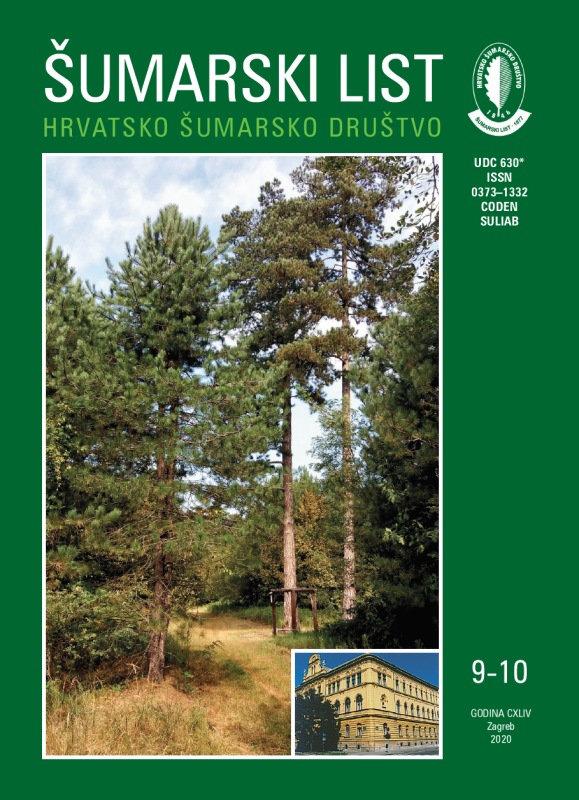
broj: 9-10/2020
pdf (6,75 MB) |
|
||||||||||||||
| RIJEČ UREDNIŠTVA | ||
| Uredništvo | ||
| How do we manage forests of small owners/holders in the Republic of Croatia pdf HR EN | 441 | |
| IZVORNI ZNANSTVENI ČLANCI | ||
| Mara Marić, Ivana Vitasović-Kosić | UDK 630* 270 + 232.1 (001) https://doi.org/10.31298/sl.144.9-10.1 | |
| Horticultural species of the island of Lokrum in the period of archduke Maximilian of Habsburg (1859–1869) and their current state pdf HR EN | 443 | |
| Martin Bobinac, Siniša Andrašev, Nikola Šušić, Andrijana Bauer-Živković, Đura Jorgić | UDK 630* 561 (001) https://doi.org/10.31298/sl.144.9-10.2 | |
| Growth and structure of italian alder (Alnus cordata /Loisel./ Duby) linear plantation at age 11 and 16 years at Fruška gora (Serbia) pdf HR EN | 455 | |
| Hanife Erdogan Genç, Ali Ömer Üçler | UDK 630* 232.3 (001) https://doi.org/10.31298/sl.144.9-10.3 | |
| Seed dormancy removal treatments and germnaton characterstcs of Acer trautvetteri Medvedev seeds pdf HR EN | 465 | |
| PRETHODNO PRIOPĆENJE | ||
| Antonio Vidaković, Marilena Idžojtić, Tonko Megyery, Dragan Turk, Igor Poljak | UDK 630* 272 https://doi.org/10.31298/sl.144.9-10.4 | |
| Kralj Petar Krešimir IV. park in Zagreb – woody plants pdf HR EN | 475 | |
| Miroslav Benko | UDK 630* 226 https://doi.org/10.31298/sl.144.9-10.5 | |
| Systematic monitoring of the conversion of pedunculate oak (Quercus robur L.) and sessile oak (Quercus petraea L.) seedlings with regard to different planting methods pdf HR EN | 485 | |
| PREGLEDNI ČLANCI | ||
| Margarita Bego | UDK 630* 832 + 836 https://doi.org/10.31298/sl.144.9-10.6 | |
| From forest to marquetry pdf HR EN | 497 | |
| SUMMARY The aim of this paper is to show the importance of forest protection as one of the factors of the preservation of Croatian cultural heritage. Forests are a natural resource and a source of material used in the restoration of wooden objects of artistic value and in this case it is about a specific restoration skill - the art of marquetry. Veneers as wood products obtained by technological processes play a very important role in terms of forest protection and marquetry. Wood is a material that has been used throughout history, and its proper maintenance and use prolong its lifespan. It must be emphasized that this material has distinct physical, mechanical, chemical and aesthetic properties. This paper focuses on its aesthetic properties: lustre, fineness, colour and texture. Marquetry is an art technique developed in the 13th century which has its roots in ancient Egypt and Rome. It is the art of inserting materials to decorate surfaces and objects. Veneers are the most important element of marquetry. Several methods of marquetry developed through history, of which the following stand out: Tarsia certosina, Tarsia geometrica, Tarsia a toppo, Tarsia a Incastro called Boulle’s technique. This paper presents the simplest hand-made marquetry with a given motif. An overview of simple marquetry covers the entire process starting with the selection of veneer to the making of marquetry by the Boulle technique. The development of marquetry technique through history was accompanied by the development of tools for veneer processing and marquetry. Rich inlays created by Boulle’s technique on authentic chests of drawers and closets of great cultural value found in the holdings of Dubrovnik museums prove that the rich cultural heritage is much more than just a one-sided approach to observing all segments mentioned in this paper which are different and yet related interdisciplinary. Therefore, it could be said that fine art rests in the forest. Key words: wood; veneers; marquetry; marquetry techniques | ||
| Tomislav Poršinsky, Josip Matas, Dubravko Horvat, Andreja Đuka | UDK 630* 307 https://doi.org/10.31298/sl.144.9-10.7 | |
| Tyres of forestry vehicles pdf HR EN | 509 | |


